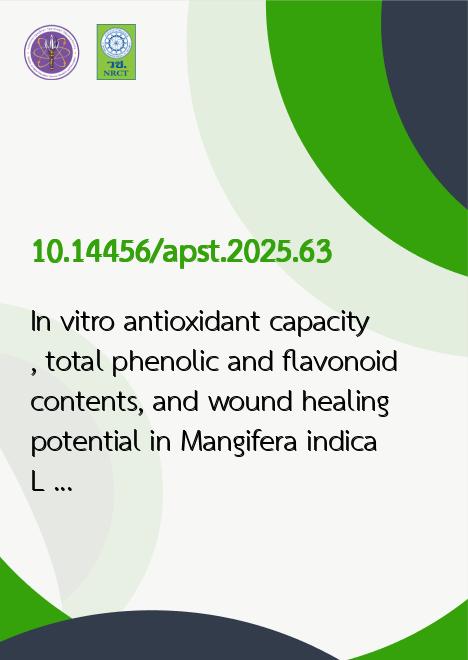
|
In vitro antioxidant capacity, total phenolic and flavonoid contents, and wound healing potential in Mangifera indica L. leaf extracts |
|---|---|
| รหัสดีโอไอ | |
| Creator | Panthip Rattanasinganchan |
| Title | In vitro antioxidant capacity, total phenolic and flavonoid contents, and wound healing potential in Mangifera indica L. leaf extracts |
| Contributor | Kittipat Sopitthummakhun, Wicharn Janwitayanuchit |
| Publisher | Khon Kaen University, Thailand |
| Publication Year | 2568 |
| Journal Title | Asia-Pacific Journal of Science and Technology |
| Journal Vol. | 30 |
| Journal No. | 4 |
| Page no. | 14 (11 pages) |
| Keyword | Mangifera indica L., human keratinocyte, wound healing activity, maceration, antioxidant capacity |
| URL Website | https://apst.kku.ac.th/ |
| Website title | https://apst.kku.ac.th/in-vitro-antioxidant-capacity-total-phenolic-and-flavonoid-contents-and-wound-healing-potential-in-mangifera-indica-l-leaf-extracts/ |
| ISSN | 2539-6293 |
| Abstract | Mangifera indica L. is a rich source of biological active compounds, prominently Mangiferin, characterized by its glycosylated xanthone structure. This compound is abundant in various edible sources, such as mango, and exhibits diverse biological activities. Extensive investigation into Mangiferin has highlighted antioxidant, anti-inflammatory, antidiabetic, anticancer, and antimicrobial properties. In this study, Mangiferin extract was prepared through maceration in 80% ethanol, yielding 1,628 g from an initial dry leaf mass of 4,234 g of dried leaf material. The ethanolic extract showed notable torox equivalent antioxidant capacity (TEAC) values for 2,2-diphenyl-1-picrylhydrazyl (DPPH) and 2,2'-azino-bis (3-ethylbenzothiazoline-6-sulfonic acid) (ABTS) assays, measured at 0.32 ± 0.03 and 0.56 ± 0.01 mM Trolox equivalents per gram dry material, respectively. The ferric reducing ability power (FRAP) value was determined to be 6.95 ± 0.40 mM FeSO4 per milligram dry material. 3-(4,5-dimethylthiazol-2-yl)-2,5-diphenyltetrazolium bromide (MTT) assays conducted on human adult calcium temperature (HaCaT) cell line indicated that concentrations ranging from 3.90 to 31.25 µg/mL did not significantly impact cell viability. Evaluation of the wound healing of the Mangiferin ethanolic extract demonstrates a consistent decrease in wound area for treated cells compared to untreated controls, with significant decreases observed after 48 hours (p < 0.05). These findings support the antioxidant and wound healing properties of the Mangiferin ethanolic extract, underscoring its therapeutic potential in promoting wound repair. |